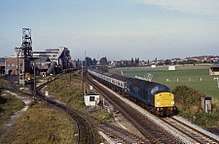Kiveton Park Colliery
 40001 Kiveton Park Colliery | |
| Location | |
|---|---|
 Kiveton Park Colliery | |
| Country | England |
| Coordinates | 53°20′21″N 1°15′48″W / 53.33917°N 1.26333°WCoordinates: 53°20′21″N 1°15′48″W / 53.33917°N 1.26333°W |
| Production | |
| Products |
Coal Coke[1] |
| History | |
| Opened | 1866[2] |
| Closed | 1994 |
Kiveton Park Colliery was a coal mine in the village of Kiveton Park, near Rotherham, South Yorkshire, England. Until 1845 Kiveton was a rural village, the main work being in agriculture. In that year a railway was built through the district which connected Sheffield with Worksop, Retford and Grimsby. This became part of the Manchester, Sheffield and Lincolnshire Railway and gave a major transport system which, almost 20 years later, saw coal, mined at many locations along the line, being sold to merchants in the Manchester area and in the port of Grimsby.
Overview
In 1864 Carrington and Company leased rights to mine coal in the area around Kiveton, sinking beginning on 6 June 1866 and the Barnsley seam being reached on 5 December 1867, just over 400 yards (370 m) below the surface. The company bore their name until 1873 when the Kiveton Park Colliery Company was founded. Initially gas was obtained from the Beighton Gas Company but in the 1870s the company began to make their own. This lasted until 1956 when it drew its supply from the grid.
A new shaft, sunk in 1886 to reach the Thorncliffe seam, reached its target at a depth of almost 700 yards (640 m). This coal was used for coking purposes and coke ovens were built adjacent to the colliery. The seam, because of a band of dirt at its centre, was, at that time, an uneconomic proposition and abandoned only 10 years after work commenced. Another shaft was sunk adjacent to that serving the Barnsley seam and connected to it. For ventilation purposes this shaft was taken down to the Silkstone seam at over 700 yards (640 m). Passing through the High Hazels seam at just over 300 yards (270 m) this was opened up in 1900 because of its very good quality house coal, the small coal mined was used for manufacturing purposes. Until 1929 all coal was mined by hand but in the years to 1940 the mining was mechanised.
In 1928 an amalgamation took place between Kiveton Park and Sherwood Collieries and in 1944 they were taken over by the United Steel Companies. The mining industry was nationalised in 1947.
The Barnsley seam was worked out in 1970, after just over 100 years of providing coal from its reserves. The colliery was closed in 1994.[3]
John Dennis, great-grandfather of comedian Hugh Dennis, was a miner at Kiveton Park Colliery.[4]
Both the colliery offices and the pithead baths were grade II listed in October 1986. The offices date from 1875 and their listing makes note of their unusual survival in the South Yorkshire Coalfield.[5][6] The pithead baths, despite being a listed structure, was demolished in late 2013.[7] Much of the former site to the south of the colliery offices was remediated and landscaped before opening as the Kiveton Community Woodland.[8][9]
Incidents
References
- ↑ "Durham Mining Museum - Kiveton Park Coal Co. Ltd". www.dmm.org.uk. Retrieved 2 May 2018.
- ↑ "Sheffield Coalfield - Northern Mine Research Society". nrms.org.uk. Retrieved 2 May 2018.
- ↑ Historic England. "Kiveton Park Colliery (888316)". PastScape. Retrieved 2 May 2018.
- ↑ "Hugh Dennis". Who Do You Think You Are?. Series 9. Episode 5. 12 September 2012. BBC.
- ↑ Historic England. "Kiveton Park Colliery Offices (Grade II) (1286364)". National Heritage List for England. Retrieved 2 May 2018.
- ↑ Historic England. "Bath-House at Kiveton Park Colliery (Grade II) (1151908)". National Heritage List for England. Retrieved 2 May 2018.
- ↑ Gallimore, Hayley (15 August 2013). "Kiveton: Last look inside pithead baths". Worksop Guardian. Retrieved 2 May 2018.
- ↑ "Kiveton Community Woodland". www.forestry.gov.uk. Retrieved 2 May 2018.
- ↑ "Kiveton Community Woodland - The Land Trust". thelandtrust.org.uk. Retrieved 2 May 2018.
- ↑ Elliott, Brian (2006). South Yorkshire Mining Disasters - Volume One; the Nineteenth Century. Barnsley: Wharncliffe Books. p. 146. ISBN 1-904325-65-6.
- ↑ "COLLIERY EXPLOSION, KIVETON PARK. (Hansard, 26 June 1941)". api.parliament.uk. Retrieved 2 May 2018.
- East of Sheffield by Roger Milnes. "Forward" - The journal of the Great Central Railway Society, No.16, July 1984. ISSN 0141-4488 (This article also uses unpublished material researched for "East of Sheffield" from various sources including members of the Kiveton and Wales Local History Group).
- Official Company Handbook of the United Steel Companies.